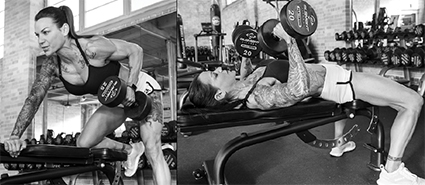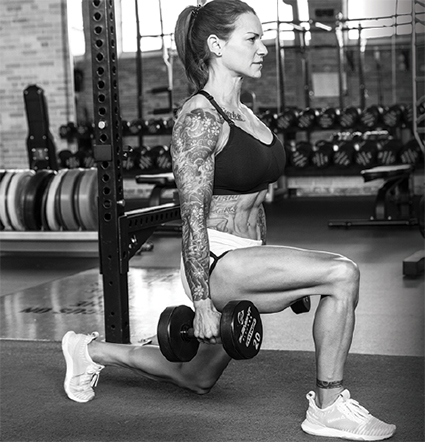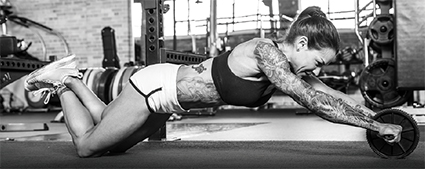Can You Lose Fat Without Cardio?

Train all muscle groups with weights every workout and you’ll burn way more calories, both during and after your training sessions.
Many people right now are experiencing the holiday hangover—that unfortunate end-of-year situation in which you ate way too much but didn’t quite work it all off. Sound familiar? Maybe even like the New Year’s resolution you made a year ago? And yet here we are again with even more unwanted body fat to lose.
Every January you’re barraged with promises offering thesolution, but by now you know it’s going to take hard work with very few shortcuts. The good news—and it’s truly good news—is that there’s a better way to burn fat faster, it’s backed by recent scientific research, and it doesn’t even include cardio. It combines traditional resistance training in ways you never imagined. Essentially, you do full-body training but not by following a traditional training split, but rather working all the major muscle groups everyworkout.
Trial by Fire

I’ve personally been doing full-body workouts for nearly two years. Like many people reading Muscle Insider, I have a bodybuilding background, so I’d been doing typical body-part split training for countless years. But in early 2017, I completely ruptured my right quadriceps tendon, which meant high-impact cardio activities such as running and jumping were completely off the table for many months thereafter while I rehabbed and recovered from multiple surgeries. Limited in what exercises I could do, I needed a new way to train, and I wanted to stay lean.
That’s when I started doing full-body workouts, based in part on one particular 2016 study from New Zealand that showed full-body training burned more fat than split-body workouts.1Researchers had weight-trained male rugby players follow either a full-body training split done three times per week or a three-day training split, with total weekly volume being the same for both programs. The results from the study showed significantly better fat lossin the full-body training group, where subjects had a 6 percent drop in body fat versus only a 2 percent drop in the split-body training group.
I decided to take full-body training to an even higher level than the New Zealand study: Instead of three full-body workouts per week, I started hitting the whole body five or six days in a row with only one or two days off from the gym per week. And when I say full-body workouts, I mean it—doing at least one exercise each for 10 different muscle groups: chest, back, shoulders, legs (quads/hamstrings), triceps, biceps, traps, forearms, calves, abs.

It worked. I was able to stay as lean as ever—at 50 years old, mind you—with no traditional cardio. The frequent full-body workouts burned enough calories to keep the body fat off while helping me maintain all my hard-earned muscle mass I had previously built.
If you’re wondering howit works, there are two major reasons why full-body training burns more fat: greater gene activation and a greater EPOC effect.
Fat Booster 1: Greater Gene Activation
From a physiological and biochemical perspective, it makes perfect sense that full-body training would lead to greater fat loss than split-body workouts.
When you exercise a muscle, you activate genes within the fibres. Those genes boost the metabolic rate of the muscle cells, as well as initiating muscle-growth processes. Both of these result in increased calorie burning. That said, if you train 10 muscle groups in a workout, you’ll burn more calories and fat than if you train only one or two muscle groups in the session.

Fat Booster 2: Greater EPOC
On top of gene activation, every time you train a muscle you cause fatigue, and that fatigue requires calories for recovery. All too often, people focus on how many calories they’re burning duringa workout, which is why cardio is usually the number one choice for those looking to get leaner.
More critical for dropping fat, however, is the number of calories you burn afteryour training, even for as long as 24 hours afterward. The ability to burn calories after working out is known scientifically as excess post-exercise oxygen consumption(EPOC). It refers to the fact that after workouts, you take in more oxygen for recovery purposes, which in turn burns more calories. (In fact, a helluva lot!) Intense weight-training will elicit more EPOC than regular cardio activity, as will full-body workouts versus split-body training. The higher the EPOC, the more calories you’re burning. What makes training “intense”? Moderately heavy loads are superior to light ones! Don’t go high rep, thinking more reps will get you there. They won’t!
Want evidence of EPOC at work? After a hard, intense workout, your body has to work overtime to return to equilibrium, thus burning more calories. If you’ve ever taken a post-workout shower and noticed you’re sweating again even before getting your clothes on, that’s evidence your body is still trying to eliminate heat.
Think about it. By training at a higher intensity for 60 minutes, you can elevate your metabolism for the remaining 23 hours of the day. That’s the best deal you’ll find anywhere in pursuit of your New Year’s resolution.

Designing a Full-Body Program
A lot of thought goes into the full-body training plans I design for JimStoppani.com, so it’s hard for me to offer a cookie-cutter system for how to go about putting together your own program. That said, here are a handful of guidelines to help get you started.
Train more days than you rest. Most of my programs include five full-body workouts per week (e.g., Monday through Friday), though some entail six (or even seven) weekly sessions. High training frequency is crucial for maximizing fat loss. If five to seven days per week doesn’t fit your schedule, at least shoot for four days a week, and try to be as active as possible on your off days from the gym.
Train all muscle groups in all workouts. Again, the whole point is to stimulate and fatigue as much muscle mass as possible each session. That’s why I program for 10 different body parts in every workout: chest, back, shoulders, legs, triceps, biceps, traps, forearms, calves, and abs. However, if you’re short on time in the gym, you can probably get away with dropping smaller body parts such as traps, forearms, and calves. For optimal muscle balance, though, try to hit all 10 muscle groups regularly.
Mind your volume. Generally speaking, 2 to 4 sets are performed for each muscle group in all workouts in my programs (with some exceptions). Over the course of five workouts, this puts you at anywhere from 10 to 20 sets per muscle group for the week, which is a typical training volume for a splitroutine. How many total sets I do for the week depends on the intensity of those sets; if it’s only 10 sets, that’s probably because each set is taken beyond failure with techniques like drop sets and/or rest-pause. If you opt for the higher volume, training past failure is less relevant.
Vary your exercises. When you’re training all muscle groups four to six days straight, variety is important to promote balance and avoid plateaus. Compound (multi-joint) exercises are going to hit the most muscle mass and provide greater bang for your buck than single-joint movements. So-called isolation exercises can be done even for larger muscle groups to complement the multi-joint movements but never instead of them. Utilize all angles, planes of movement, and equipment possible. And keep in mind, while I said I do 2 to 4 sets per muscle group, that doesn’t mean I always do only one exercise per body part; I may in fact do multiple exercises per muscle group but just one set each, proceeding without rest.
Vary your techniques. Let’s say you’re doing 10 exercises (one per muscle group) in a workout. But those exercises don’t have to be performed as straight sets; you can also do them as part of a circuit. Each of my programs has at least one featured theme or technique—i.e., supersets, drop sets, giant sets, a particular periodization scheme, etc. These should all be fair game in your program. My full-body training programs run the gamut in terms of exercise selection, load, sets and reps, rest periods, rep speeds, and intensity-boosting techniques.
Add cardio if desired. Doing full-body workouts doesn’t mean you can’t do cardio as well. Feel free to add the HIIT-style cardio routine of your choice to the end of any lifting workout or on off days from the gym to further enhance conditioning and calorie burning.

References
1 Crewther BT, Heke T, Keogh J. The effects of two equal-volume training protocols upon strength, body composition and salivary hormones in male rugby union players. Biol Sport. 2016 Jun;33(2):111-6.

